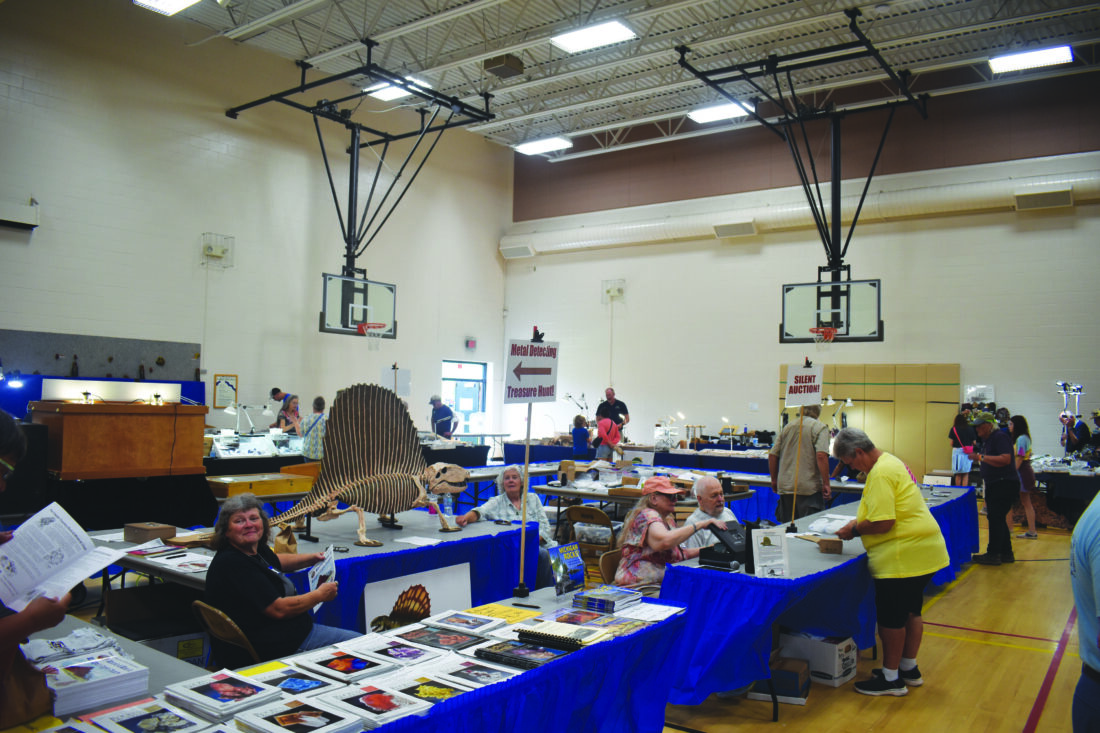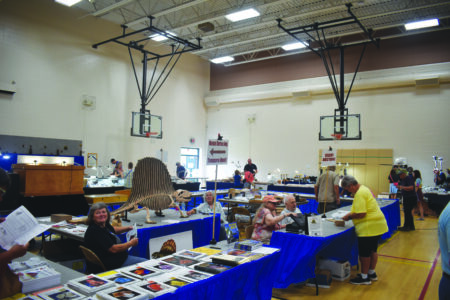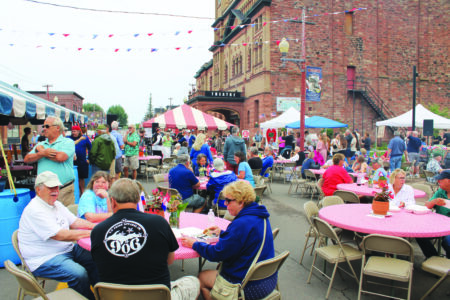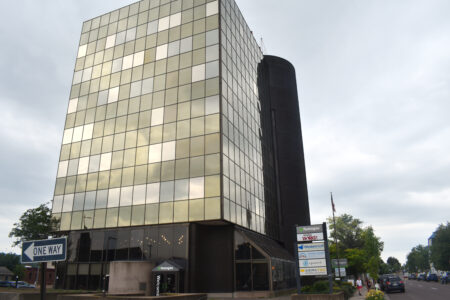Rock on!
Rock and Mineral Club hosts annual event

Ben Garbacz/Daily Mining Gazette The Copper Country Rock and Mineral Show took place over the weekend at the Houghton Elementary School. Vendors displayed several rock specimens and other related items for sale in the school gym while attendees discussed their interest in geology and other earth sciences.
HOUGHTON — The Copper Country Rock and Mineral Club hosted its annual show at Houghton Elementary School over the weekend. The event began Friday with club members and visitors meeting and discussing their mutual interest in geology, paleontology and earth science while browsing mineral vendors’ wares and displays.
The club uses the show each year to offer members, and anyone interested in rocks and minerals, a chance to browse a wide selection of specimens for purchase, though the show coordinator and club member George Schriver said the emphasis for the event is placed on gaining children’s interest in the world of rocks and minerals.
“It’s a great introduction to science,” Schriver said. “All the sciences are wrapped up in geology: physics, chemistry — the whole works.”
Schriver explained children at a young age are fascinated by the appearance of rocks and minerals especially specimens which are shiny and colorful, but if they keep their interest in the rocks it can lead to interest in physics, history and other aspects of their favorite rock specimens. Other events aimed at youth included a metal detecting pool and a presentation on the prehistoric animal, the dimetrodon.
The metal detecting pool allowed children to use metal detectors to scan for coins and copper pieces in a sawdust pile. If children found a coin or copper nugget, they were allowed to keep it.
The presentation on the dimetrodon was conducted by Lone Star College’s Professor of Geological Sciences Nathalie Brandes. Brandes lives and teaches in Texas, but has ties to the area by completing graduate school at Michigan Tech and marrying someone from. Brandes is also a Copper Country Rock and Mineral Club member and has given presentations at the show for years.
The presentation began in a classroom where Brandes went over the history of the animal and where it lived on Earth during the times of the Pangea supercontinent. Dimetrodon lived around what is now Utah, New Mexico and western Texas. She shared the basic biology which has been studied from the animal’s fossils and explained the dimetrodon is actually a protomammal and not a dinosaur.
She also taught the children why there are less fossils from that time period discovered in places such as Michigan. Brandes explained this by going over the geological and climate history of the state, which included the ice age’s glacial retreat which moved many such fossils away from the region.
Brandes brought those attending the presentation to the gymnasium where a cast of a dimetrodon was on display. There she revealed more about the biology of the animal and then held a raffle for a dimetrodon plushie. She said she always enjoys giving these presentations to children. “Kids really like prehistoric life,” Brandes said. “And the club is really into exposing kids to science in general and getting them interested in the earth sciences. And we thought by having a prehistoric life form that’s very eye catching and very interesting, that it might appeal to some kids.”
While science is an important aspect of geology and getting children involved is important for the club, Schriver said it is important to realize the area’s history is all tied to the mineral which drew people to the mines — copper.
“We’re at one of the most historic mining districts in the world. Copper that we have here is unmatched anywhere in the world. Native copper just doesn’t happen; there’s occurrences of it, but it’s never been mined successfully. And our mines started up in the 1840s, in 1848 they started just getting involved at the Cliff and at Central and they mined steadily for about 150 years. The amount of copper that came out of here is in the billions with a ‘b’ and there’s a lot of leftovers on the piles they didn’t want,” Schriver said.
The show’s media advertiser and Quincy Mine Hoist Association board member Gaylord Faull said it is geology that made Copper Country special. He said if it were not for copper, all that would have made people come to the area was outdoor recreation and many families would not have their heritage here.
“My great grandfather came over from Finland in 1895 and worked in the mines, you know,” Faull said. “And that’s my connection to this. Most of the kids up here that are local should understand that it’s not just a rock. There’s more to it than that.” Faull added without copper and the mining industry, there would be no Michigan Tech since it began as a mining college, and Michigan Tech began the careers of engineers and scientists.
Copper is the mineral the club has the most interest in, and Schriver said members enjoy coming into contact with it the most. Mineral hunting is also another aspect club members enjoy. “If you’re an old hand at collecting or a geologist like myself, seeing some of the variety of minerals that people bring to sell or trade is a lot of fun, because they can go to places I can’t and get things that I can’t usually see,” Brandes said.
Seven full vendors and two smaller vendors were present at the show, all with different items to be sold and won via a silent auction. More than rock specimens were being sold, with some vendors featuring jewelry and literature on the subject of earth sciences. Among these vendors was Matt Marohn of Calm Crystals and Minerals from Black Creek, Wis. Marohn has been coming to the show for years with a liking to the area’s beauty, history with copper mining and an interest in agates.
“A lot of my customers travel up to the U.P. to go along Lake Superior and camp and walk the beaches looking for agates,” Marohn said. He said agates are a popular item at his shop and the history of the area which produces many agates is interesting to discuss at the event.




